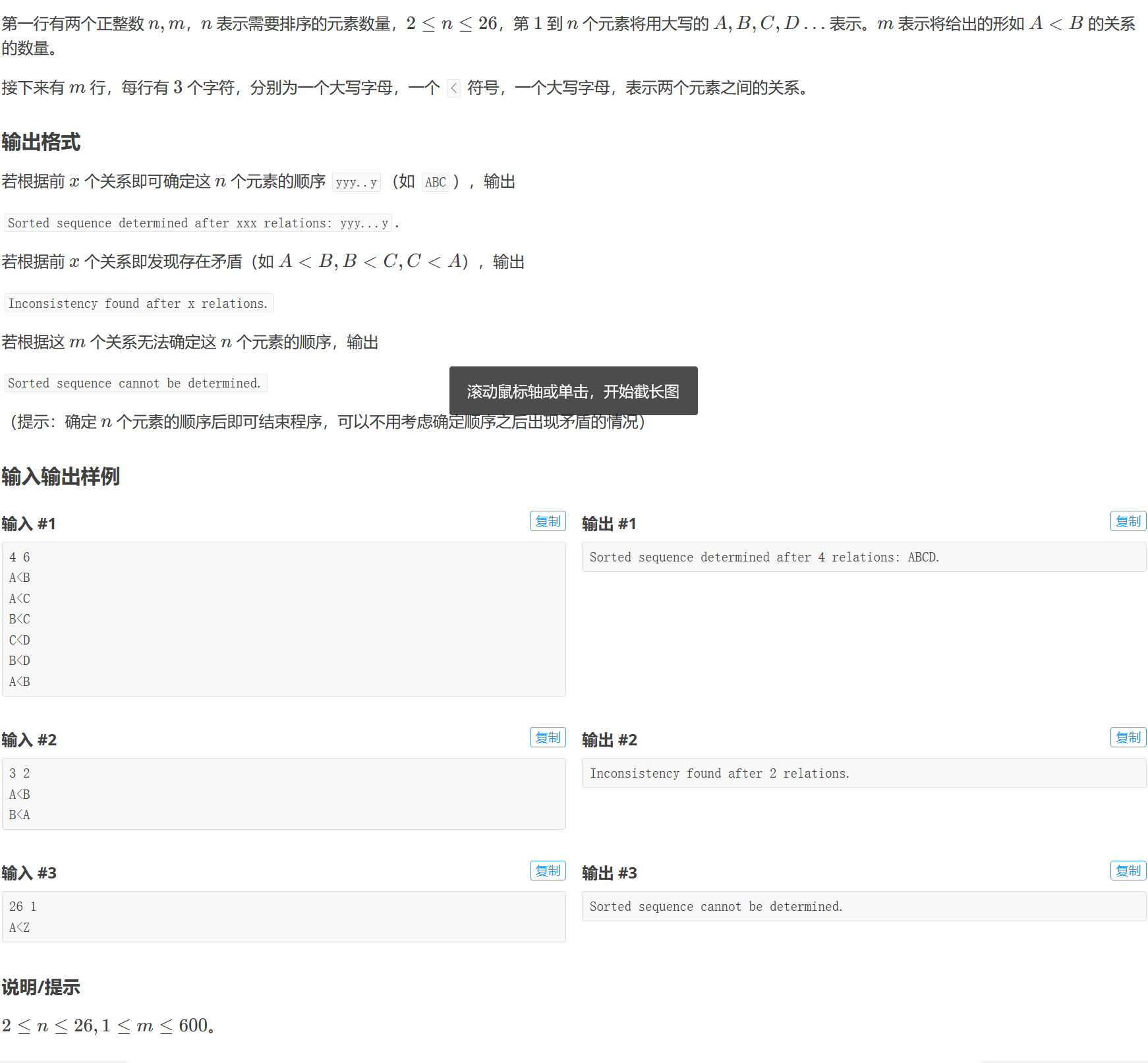题意看起来稍微有点复杂,还好数据很弱,可以放心进行各种处理.
这里的关系具有方向性,用图存储.A>B存储为一条A→B的边.
当给定一些关系后,只可能存在三种状态:
- 关系出现了环
- 关系没有环,且进行拓扑排序时每"层"只会发现一个入度为0的点,且图是联通的
- 上述状态之外的状态
只要已知的关系还没有出现环,那么只要之后给出足够多的关系总是有可能得出一种正确的排序.而只要出现了环,就已经发生了错误.
在尚未出现环的情况下,只要发现图联通且拓扑排序的每"层"总是只有一个入度为0的点,就已经找到了解,否则需要加入更多的关系.
很容易就可以写出来这样的流程,每一种要进行的判断和操作都很容易实现,只是有点繁琐.

#include <algorithm> #include <cstdio> #include <cstring> #include <iostream> #include <queue> #include <stack> #include <vector> using namespace std; vector<int> s[30]; bool used[30], exist[30]; int n, m, fa[30], deg[30], tmp[30]; int get(int x) { return fa[x] == x ? x : fa[x] = get(fa[x]); } void merge(int x, int y) { fa[get(y)] = fa[get(x)]; } bool dfs(int x) { // check circle if (!x) return true; // printf("DFSING %c ", x + 'A' - 1); used[x] = true; for (auto i : s[x]) if (used[i]) return true; else if (dfs(i)) return true; used[x] = false; return false; } int check() { // Finish - 1 bad - -1 continue - 0 bool good = true; // check 1 used[30] = {0}; // check -1 int head = 0; for (int i = 1; i <= n; i++){ if (exist[i] && !deg[i]) { if(head) good = false; head = i; } if (dfs(i)) return -1; } int base = 0, ct = 0; for (int i = 1; i <= n; i++) { if (!exist[i]) continue; else ct++; if (!base) base = i; if (get(base) != get(i)) { good = false; break; } } if (good) { memcpy(tmp, deg, sizeof(deg)); queue<int> q; q.push(head); while (!q.empty()) { if (q.size() > 1) return 0; int cur = q.front(); q.pop(); for (auto i : s[cur]) { tmp[i]--; if (!tmp[i]) q.push(i); } } if (q.size() > 1) return 0; if (ct == n) return 1; else return 0; } return 0; } int main() { // freopen("in.txt", "r", stdin); // freopen("out.txt", "w", stdout); for (int i = 1; i <= 30; i++) fa[i] = i; cin >> n >> m; char x, y, opr; for (int i = 1; i <= m; i++) { cin >> x >> opr >> y; exist[x - 'A' + 1] = exist[y - 'A' + 1] = true; if (opr == '>') { s[x - 'A' + 1].push_back(y - 'A' + 1); deg[y - 'A' + 1]++; } else { s[y - 'A' + 1].push_back(x - 'A' + 1); deg[x - 'A' + 1]++; } merge(x - 'A' + 1, y - 'A' + 1); // printf("%d CHECKING MERGED %c %c ", i, x, y); int stat = check(); if (stat == 1) { printf("Sorted sequence determined after %d relations: ", i); int head = 0; for (int i = 1; i <= n; i++) if (!deg[i]) { head = i; break; } queue<int> q; stack<int> ans; q.push(head); while (!q.empty()) { int cur = q.front(); q.pop(); ans.push(cur); for (auto i : s[cur]) { deg[i]--; if (!deg[i]) q.push(i); } } while (!ans.empty()) { printf("%c", ans.top() + 'A' - 1); ans.pop(); } puts("."); return 0; } else if (stat == -1) { printf("Inconsistency found after %d relations. ", i); return 0; } } puts("Sorted sequence cannot be determined."); return 0; }
实际上,判断图中有无环只需要检查拓扑排序后是否存在未遍历的点.

